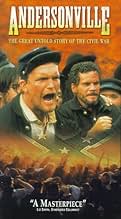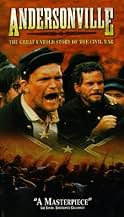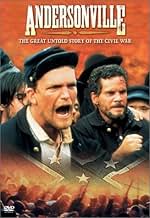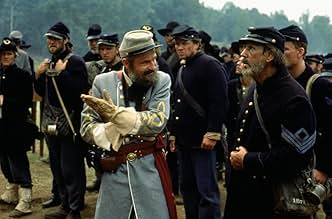IMDb RATING
7.3/10
2.2K
YOUR RATING
The story of the most notorious Confederate prisoner of war camp in the American Civil War.The story of the most notorious Confederate prisoner of war camp in the American Civil War.The story of the most notorious Confederate prisoner of war camp in the American Civil War.
- Won 1 Primetime Emmy
- 3 wins & 10 nominations total
Browse episodes
Featured reviews
The movie Andersonville was one of intense drama. The historical subject matter made the film all the more pertinent to society today. Man against Man, Brother against Brother. That is what the Civil War was, and Andersonville was its worst. Men treating other men like animals and game for sport. The utter despair. The terrible suffering.
Andersonville is set during the Civil War, in the south, in a Prisoner Of War camp run by the Confederate Army. The story depicts the conditions of suffering that the Union soldiers endured while held captive. The best and the worst of humanity is shown in this film as the viewer is shown all ends of the spectrum of pain and suffering.
Peter Murnik's character, Limber Jim, was the voice of conscience in this film. Jim was the one who finally stood up to the injustice that other Union soldiers were enacting against their fellows. It was Jim who rallied the troops to a riot to stop the "Raiders" from continuing their carnage. Not a single 'Peter' scene went by without the viewer sensing the intensity. He portrayed it in his face, in his demeanor and most of all, in his eyes. In this film, Peter said so much without uttering a word. The look he gave in his eyes told the viewer the intensity of his feelings. His determination. His desire to see the wrongs righted. In a sense, Limber Jim was one of the saviours of this film. His standing up to the injustice he witnessed and lived through, enabled his fellow prisoners to also rise up and change the world around them, as small as it was.
In spite of the fact that this was a film and an artistic production, the real Andersonville shone through. The viewer came away knowing the despair that the Union soldiers felt and lived. There was no question that humanity, as a whole, had been wronged by the cruelty that took place at Andersonville. The human race came away from Andersonville worse off for having realized that we could fall so far from the very civilization we pride ourselves on creating to treat other fellow human beings the way the Union soldiers were treated.
Andersonville actually existed, and does so today as a Federal Park and tourist attraction. This movie is a very good link in telling the tale that so many never got to tell. The actors, staff and crew of Andersonville did such a magnificent job that anyone seeing this movie will know what it was like to have been there. They will know the suffering, the pain, the disease, the despair. The cast and crew are to be applauded for their efforts.
In his bio, Peter lists Andersonville as one of the projects he is most proud of. And, well he should be. He did an excellent performance and is to be commended. It will go down as one of the favorites with his fans. Once again, Peter's genius comes shining through.
Andersonville is set during the Civil War, in the south, in a Prisoner Of War camp run by the Confederate Army. The story depicts the conditions of suffering that the Union soldiers endured while held captive. The best and the worst of humanity is shown in this film as the viewer is shown all ends of the spectrum of pain and suffering.
Peter Murnik's character, Limber Jim, was the voice of conscience in this film. Jim was the one who finally stood up to the injustice that other Union soldiers were enacting against their fellows. It was Jim who rallied the troops to a riot to stop the "Raiders" from continuing their carnage. Not a single 'Peter' scene went by without the viewer sensing the intensity. He portrayed it in his face, in his demeanor and most of all, in his eyes. In this film, Peter said so much without uttering a word. The look he gave in his eyes told the viewer the intensity of his feelings. His determination. His desire to see the wrongs righted. In a sense, Limber Jim was one of the saviours of this film. His standing up to the injustice he witnessed and lived through, enabled his fellow prisoners to also rise up and change the world around them, as small as it was.
In spite of the fact that this was a film and an artistic production, the real Andersonville shone through. The viewer came away knowing the despair that the Union soldiers felt and lived. There was no question that humanity, as a whole, had been wronged by the cruelty that took place at Andersonville. The human race came away from Andersonville worse off for having realized that we could fall so far from the very civilization we pride ourselves on creating to treat other fellow human beings the way the Union soldiers were treated.
Andersonville actually existed, and does so today as a Federal Park and tourist attraction. This movie is a very good link in telling the tale that so many never got to tell. The actors, staff and crew of Andersonville did such a magnificent job that anyone seeing this movie will know what it was like to have been there. They will know the suffering, the pain, the disease, the despair. The cast and crew are to be applauded for their efforts.
In his bio, Peter lists Andersonville as one of the projects he is most proud of. And, well he should be. He did an excellent performance and is to be commended. It will go down as one of the favorites with his fans. Once again, Peter's genius comes shining through.
Generally these TNT original productions are nothing what one could call spectacular. This film from John Frankenheimer however is one of the better ones. A tale of imprisonment and survival inside the notorious Confederate POW camp known as Andersonville. Civil War historians would probably with certainty find various historical inaccuracies but it is worth viewing although a tad on the long side. Good performances from many of the cast but it seems Frederick Coffin and William Sanderson do the best job as two of the ring leaders of the camps vicious "Raiders" gang. A must see for any Civil War fan.
The American Civil War, and Union soldiers are imprisoned at Andersonville, a crude stockade establishment presided over by the inept and cruel Captain Henry Wirz. It would prove to be a another dark and soul destroying chapter from the war.
Lets get it out there right away, Andersonville was not the only hell hole prison operating during the American Civil War. Information from both sides of the coin is available on line for those wishing to explore further. That said, Andersonville is a story that deserved and is needed to be told, and this John Frankenheimer directed two - parter brings it vividly into the viewers' lives.
In filmic substance terms it has all the standard POW movie cliche's. We follow a group of prisoners and a group of "convict bullies", with those in authority observing menacingly and proving desperately carefree as to the conditions of the prison and of humane traits in general.
But as formulaic as it ultimately is, there's a determination by the makers to keep the characterisations real and viable, and they achieve this in spades. Pic is also boosted by superb period detail, costuming is grade "A", while the production and art design for the prison is harrowingly effective.
Frankenheimer's tracking shots brings home the enormity of the misery, while Gary Chang's score is thankfully never bombastic. Cast are a mixed bag - to be expected in such a large ensemble piece - and you can't help but yearn for more of William H. Macy.
Yet even though 30 minutes could easily have been shaved off of the run time, Andersonville is a production that should stay with you. The coda serving to remind us that that should be the case. 7/10
Lets get it out there right away, Andersonville was not the only hell hole prison operating during the American Civil War. Information from both sides of the coin is available on line for those wishing to explore further. That said, Andersonville is a story that deserved and is needed to be told, and this John Frankenheimer directed two - parter brings it vividly into the viewers' lives.
In filmic substance terms it has all the standard POW movie cliche's. We follow a group of prisoners and a group of "convict bullies", with those in authority observing menacingly and proving desperately carefree as to the conditions of the prison and of humane traits in general.
But as formulaic as it ultimately is, there's a determination by the makers to keep the characterisations real and viable, and they achieve this in spades. Pic is also boosted by superb period detail, costuming is grade "A", while the production and art design for the prison is harrowingly effective.
Frankenheimer's tracking shots brings home the enormity of the misery, while Gary Chang's score is thankfully never bombastic. Cast are a mixed bag - to be expected in such a large ensemble piece - and you can't help but yearn for more of William H. Macy.
Yet even though 30 minutes could easily have been shaved off of the run time, Andersonville is a production that should stay with you. The coda serving to remind us that that should be the case. 7/10
My opinion is that Andersonville is the best Civil War movie ever made, period. As a former Civil War reenactor, I'm not going to sit here and nitpick at all the "mistakes." Were there mistakes? Sure. The timeline was a little fuzzy for one. But that does not detract from the power of this movie. The guards were not well fed regulars either, but so what? You don't have to take a test after watching this movie!
I think the REAL factor in Andersonville being such a great production was the fact that you had no real "name" people involved. Fredric Forrest may have been the biggest name in the film and is a career role actor - but WHAT an actor! These guys busted their balls for this film and it really shows. I heard one reenactor complain that the characters seemed "cartoonish," and I don't buy it. I bet he was refering to Jan Triska who played Wirz. Well, read up on Wirz. I think they got it pretty close.
Forgive me, my reenacting brethern, but alhough Gettysburg was a tolerable film (I got to be an extra in that) and Gods and Generals was a disaster, the problem with these productions was the fact that they relied way too heavily on reenactors. Reenactors are NOT actors! They were used most effectively in Glory, not so well in Gettysburg, and Gods and Generals? Don't want to even go there. Andersonville followed Glory's success formula in using reenactors as background with small parts filled in by them (my buddy Martin Leibschner playing the banjo in the Raider camp was a good use of the talent reenactors can bring to film).
Frankenheimer must be given a lot of credit, as should the writer. The script did get a little cheesy here and there, but not enough again to trash the overall production. Jarrod Emick (sp?) as Josiah Day did a nice job, but until that point he had been a stage actor mostly, and his voice inflections projected that. Still, he did a great job. Peter Murnik as Limber Jim added that "mystery character" to the film well (as the real Limber Jim who was at Andersonville is a mystery to history). Again, I can't think of one lame performance by any of the key actors here. They put 110% into the job and I commend them for it. And whoever was involved in the set design was on the ball too. To try and recreate that place was no small task.
I remember a reenactor bitching because for the "filling" of the stockade for the wide shots, they had to use women and even cardboard figures. Big frekin deal! When they are dots on the screen, did it REALLY matter?
I can't see this movie being topped in terms of a Civil War period piece. Hollywierd is always bent on turning just about every period piece into some type of romance for the younger target audience. Andersonville is certainly a refreshing change of pace to that drill.
I think the REAL factor in Andersonville being such a great production was the fact that you had no real "name" people involved. Fredric Forrest may have been the biggest name in the film and is a career role actor - but WHAT an actor! These guys busted their balls for this film and it really shows. I heard one reenactor complain that the characters seemed "cartoonish," and I don't buy it. I bet he was refering to Jan Triska who played Wirz. Well, read up on Wirz. I think they got it pretty close.
Forgive me, my reenacting brethern, but alhough Gettysburg was a tolerable film (I got to be an extra in that) and Gods and Generals was a disaster, the problem with these productions was the fact that they relied way too heavily on reenactors. Reenactors are NOT actors! They were used most effectively in Glory, not so well in Gettysburg, and Gods and Generals? Don't want to even go there. Andersonville followed Glory's success formula in using reenactors as background with small parts filled in by them (my buddy Martin Leibschner playing the banjo in the Raider camp was a good use of the talent reenactors can bring to film).
Frankenheimer must be given a lot of credit, as should the writer. The script did get a little cheesy here and there, but not enough again to trash the overall production. Jarrod Emick (sp?) as Josiah Day did a nice job, but until that point he had been a stage actor mostly, and his voice inflections projected that. Still, he did a great job. Peter Murnik as Limber Jim added that "mystery character" to the film well (as the real Limber Jim who was at Andersonville is a mystery to history). Again, I can't think of one lame performance by any of the key actors here. They put 110% into the job and I commend them for it. And whoever was involved in the set design was on the ball too. To try and recreate that place was no small task.
I remember a reenactor bitching because for the "filling" of the stockade for the wide shots, they had to use women and even cardboard figures. Big frekin deal! When they are dots on the screen, did it REALLY matter?
I can't see this movie being topped in terms of a Civil War period piece. Hollywierd is always bent on turning just about every period piece into some type of romance for the younger target audience. Andersonville is certainly a refreshing change of pace to that drill.
John Frankenheimer pain stakingly chronicles prisoners of war struggling to survive in an ill run Confederate prison camp during the Civil War. New prisoners are savagely introduced to the pecking order in this small pit of hell. Strong images support the story line for this well written and produced epic. Featured cast members in this trial of humanity are:Frederic Forrest, William Sanderson, Jarrod Emick, Jayce Bartok, Cliff De Young, Justin Henry and William H. Macy. It is hard to find fault in this glimpse of the notorious place called Andersonville.
Did you know
- TriviaAt some point during production, several reels of film were lost on the way from a shooting location in Georgia to printing in California. Director John Frankenheimer had to reshoot the lost footage, which was about 40% of the trial sequence, in a new location in North Carolina, rebuilding parts of the original set to the last detail in order to match the coinciding Georgia scenes.
- Quotes
Sgt. McSpadden: And what do you call this little piece of heaven?
Capt. Wirz: This? This is Andersonville.
- ConnectionsFeatured in The 48th Annual Primetime Emmy Awards (1996)
- How many seasons does Andersonville have?Powered by Alexa
Details
- Runtime1 hour 24 minutes
- Color
- Sound mix
- Aspect ratio
- 1.85 : 1
Contribute to this page
Suggest an edit or add missing content







































